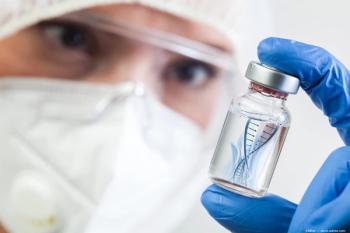
Eyepod: Ocugen CEO gives update on OCU400
In this EyePod® episode, David Hutton sits down with Shankar Musunuri, CEO of Ocugen to discuss updated data for OCU400.
In this EyePod® episode, David Hutton sits down with Shankar Musunuri, CEO of Ocugen to discuss updated data for OCU400.
Audio Transcript:
Editor’s note: This transcript has been edited for clarity.
David Hutton:
Welcome to EyePod, a podcast series from Ophthalmology Times in which we engage with key opinion leaders in interviews about the latest innovations in the areas of surgery, clinical diagnosis, therapeutics, imaging, device technology, gene and cell therapy, practice management, and other cutting-edge topics. I'm your host, David Hutton. Welcome to another edition of the EyePod Podcast. I'm joined today by Dr. Shankar Musunuri, CEO of Ocugen, to discuss updated data for OCU400. Currently in phase 1/2 clinical trial for the treatment of retinitis pigmentosa. Can you tell us about the latest data for OCU400?
Shankar Musunuri:
Yes, David, thank you for having me today. And I'd like to summarize the latest data we released recently. OCU400 continues to demonstrate a favorable safety and tolerability profile as an investigational drug product. I think it looks promising. It also continues to show clinically positive trends from multiple endpoints [inaudible]. Remember, retinitis pigmentosa is a very complex disease. And currently, we are looking at multiple mutations because we have a gene agnostic approach. So I will highlight the data – 83% of subjects demonstrated preservation or improvement in the treated eye, either with BCVA, or LLVA. BCVA refers to Best Corrected Visual Acuity, and LLVA stands for Low Light Visual Acuity.
Also, MLMT, which is a mobility course. So that's promising. I think it's important for people to understand that stabilization of a signal in this population is really good. Because typically, when you get any drug approved, you're reducing degeneration compared to the control group. That's how you get the drug approved. So if you're really stabilizing the signal, stopping the progression, that itself is a good sign. And if you're improving, that's even better, right? So from where you are, in that respect, 83% of subjects showed either preservation, meaning stability, or improvement in signals using these multiple endpoints. Seventy-five percent of them have shown improvement or stabilization with the mobility course. The mobility course is used in one of the approved products.
Only one gene therapy product, Eyespace, got approved about five years ago. Eighty-six percent of rhodopsin patients showed stabilization or improvement using either MLMT course. So that's very important. Why? Because we have a gene agnostic approach. We are testing in patients who don't have an R2E3 gene, which is the gene we're trying to give using the OCU400. They don't have a defective R2E3. This is a rhodopsin mutation. So that's really important. It is demonstrating efficacy, a trend in patients in a gene agnostic approach. That's very important for people to understand.
David Hutton:
What do these results mean for the company and its efforts with OCU400?
Shankar Musunuri:
These results are very encouraging. Number one, we've looked into many patients to date now. And number one, safety is good. So that's number one. Some of the patients have reached almost 12 months point, which is important. The next most important thing is we continue to see positive efficacy trends. As I mentioned, most of these patients, about 100,000 patients in the US, are struggling with retinitis pigmentosa. Many of them, if untreated, by mid-40s, they may become legally blind. It's a really devastating disease.
And they're really in desperate need. And if you're showing a favorable signal, stabilizing the signal or improving using multiple endpoints, that's very promising. So that will allow us to assemble the data sometime this year. We want to really discuss this information with the FDA. Using this data, we're going to design our phase three clinical trial and go to agencies and discuss with them by the end of the year and see if we can get an agreement to move into Phase Three clinical trial. That's really important, right? Because remember, phase one, two clinical trials, the primary endpoint is efficacy, safety. So if you're seeing an efficacy signal in these patients using multiple endpoints, that's very promising. It is also showing in patients in an agnostic approach and relapsing, other mutations, other R2E3.
So those are the key points to remember. Typically, in phase one, two trials, you take late-stage patients who have a disease which progressed in a way into a really advanced stage. Sometimes if you talk to the experts, they're surprised. They don't expect much improvement in the patients. But they're seeing good signals in these patients, too. So that's very encouraging to hear from experts. So, in a nutshell, this data is encouraging. We're putting a package together to discuss with agencies to see if we can get an agreement to move into Phase Three.
David Hutton:
And ultimately, what could this treatment option mean for ophthalmologists and the patients they treat?
Shankar Musunuri:
Yeah, this could be very beneficial. Let me talk about retinitis pigmentosa. Under retinitis pigmentosa, there are many retinal diseases. This is an orphan disease with about 100,000 patients in the US. There is another segment called Leber congenital amaurosis. We're recruiting patients up to 90 between the two of them. There are about 125 genes which can get mutated. So if you take a traditional gene therapy approach, you have one product covering the RPE65 gene in the market. That is in less than 1,000 patients in the US. That's one out of 125. So how about the remaining 124 mutations and over 100,000 patients sitting there? How are they going to get the rescue? It's almost impossible for pharmaceutical companies to develop 124 products to treat all those patients.
So that's where we come in. This is a modifier gene therapy. These are like Master genes in the retina. They have the ability to control the functional networks, from cell development, inflammation, metabolism to survival. They create a homeostasis, the receptor homeostasis at a molecular and cellular level, and restore the function. They also create a healthy environment for cells to survive. That's really important. That's why, because of that, these genes we can target. A gene agnostic approach has the potential to treat all these patients with these 125 mutations. So what it means is for ophthalmologists and patients, this is very significant for them.
There is hope out there if this treatment works, and they continue to work in phase three in multiple mutations. This has the potential to address this big disease burden. This is a big deal because people are thinking of single mutations in 500 patients, 2,000 patients. Rhodopsin itself has over 10,000 patients. This is not an easy mutation to treat with rhodopsin mutations. That's itself what we're testing right now, and R2E3 mutations. And that itself is big. So there is hope for the patients and physicians. If you continue to progress into phase three, and we potentially get to the other side and get good results. This treatment has the potential to treat all these patients who are desperate and in desperate need for rescue.
David Hutton:
And lastly, you pretty much hit upon this. But let's recap. What are the next steps for OCU400?
Shankar Musunuri:
The next steps are, obviously, we're progressing well in clinic. With the data we have on hand, we're going to discuss with agencies like FDA, and with our Phase Three design. So if they do agree, our goal is to move this to phase three, as we announced late this year and early next year. So that will be a controlled trial, looking into multiple mutations in phase three. What it means is our bigger goal is to get a broad indication for retinitis pigmentosa and LCA, covering all these mutations. Obviously, we do have orphan drug designations covering those broad indications like RP and LCA. So those designs have to align with FDA and ensure they're comfortable with our design.
If we reach an agreement, we're going to go into phase three. The bottom line is to initiate phase three as soon as possible. Typically, these studies run for a minimum of one year duration, just like the first product which got approved. They did a one-year endpoint. So sometimes they may need a little longer depending on the mutations. All those things will be discussed with FDA. In a nutshell, the next steps are getting in alignment with FDA and potentially initiating the phase three clinical trial at the end of this year or early next year. So that this product will be available in the market if everything goes according to our plan by 2026.
David Hutton:
Thanks for listening to this episode of EyePod by Ophthalmology Times. If there are topics you would like to hear about, let us know. You can also stay connected with us on Twitter, LinkedIn, or Instagram. We'll see you next time.
Newsletter
Don’t miss out—get Ophthalmology Times updates on the latest clinical advancements and expert interviews, straight to your inbox.



















































.png)


